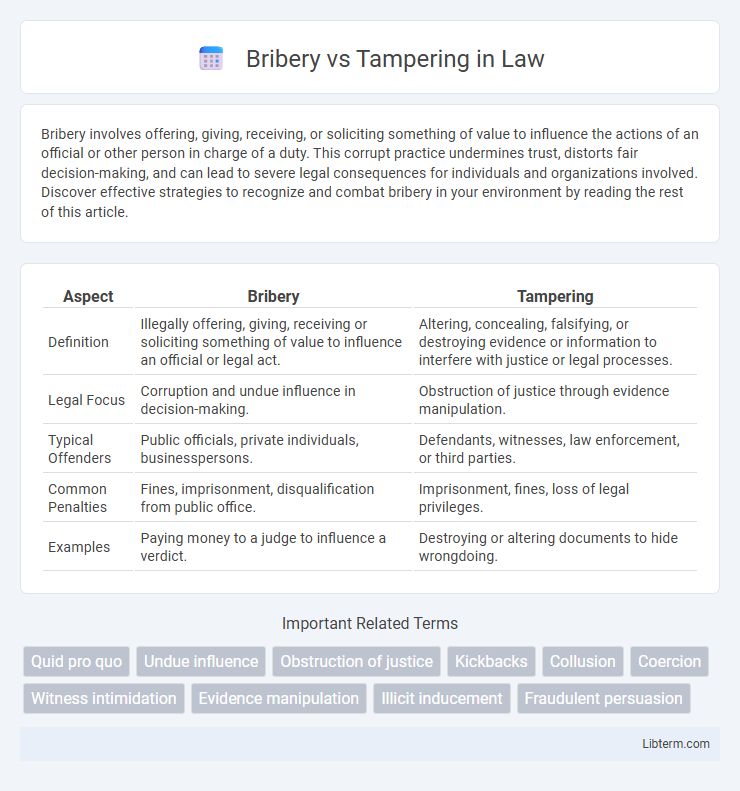Bribery involves offering, giving, receiving, or soliciting something of value to influence the actions of an official or other person in charge of a duty. This corrupt practice undermines trust, distorts fair decision-making, and can lead to severe legal consequences for individuals and organizations involved. Discover effective strategies to recognize and combat bribery in your environment by reading the rest of this article.
Table of Comparison
| Aspect | Bribery | Tampering |
|---|---|---|
| Definition | Illegally offering, giving, receiving or soliciting something of value to influence an official or legal act. | Altering, concealing, falsifying, or destroying evidence or information to interfere with justice or legal processes. |
| Legal Focus | Corruption and undue influence in decision-making. | Obstruction of justice through evidence manipulation. |
| Typical Offenders | Public officials, private individuals, businesspersons. | Defendants, witnesses, law enforcement, or third parties. |
| Common Penalties | Fines, imprisonment, disqualification from public office. | Imprisonment, fines, loss of legal privileges. |
| Examples | Paying money to a judge to influence a verdict. | Destroying or altering documents to hide wrongdoing. |
Understanding Bribery: Definition and Key Elements
Bribery involves offering, giving, receiving, or soliciting something of value to influence the actions of an official or other person in charge of a public or legal duty. Key elements of bribery include the intent to corruptly influence, the exchange of something valuable, and the connection to a specific act or decision. Unlike tampering, which focuses on interfering with evidence or the judicial process, bribery centers on corrupt transactions aimed at gaining unfair advantage.
What is Tampering? Legal and Practical Insights
Tampering refers to the deliberate alteration, adulteration, or interference with evidence, products, or systems to deceive or mislead, often resulting in compromised integrity or safety. Legally, tampering is a criminal offense under statutes like obstruction of justice or product tampering laws, carrying severe penalties including fines and imprisonment. Practically, tampering undermines trust in processes, whether in legal investigations, consumer products, or technological systems, necessitating stringent security measures and regulatory compliance to detect and prevent such acts.
Bribery vs Tampering: Core Differences
Bribery involves offering, giving, receiving, or soliciting something of value to influence the actions of an official or other person in charge of a public or legal duty. Tampering refers to the unlawful interference with evidence, documents, or systems to obstruct justice or mislead investigations. The core difference lies in bribery's focus on corrupt transactions to gain favor, while tampering centers on manipulating or destroying information to impede legal processes.
Common Forms of Bribery in Modern Society
Common forms of bribery in modern society include kickbacks, where a percentage of contract value is returned to the briber, and facilitation payments made to expedite routine government actions. Corporate bribery often involves offering financial incentives or gifts to secure business advantages or favorable regulatory treatment. Political bribery can manifest through campaign contributions or lobbying efforts aimed at influencing policy decisions.
Typical Examples of Tampering Across Industries
Typical examples of tampering across industries include altering product labels in pharmaceuticals, manipulating financial records in banking, and interfering with safety equipment in manufacturing. In the food industry, tampering often involves contaminating goods or changing expiration dates, while in electronics, it might include modifying hardware to bypass security measures. These actions compromise integrity and safety, differing from bribery, which involves offering or receiving incentives to influence decisions.
Legal Consequences: Bribery vs Tampering
Bribery carries severe legal consequences including heavy fines, imprisonment, and permanent criminal records that hinder future employment opportunities. Tampering, involving manipulation of evidence or products, results in criminal charges such as obstruction of justice, fraud, and public safety violations, with penalties including fines and incarceration. Both offenses damage reputations and may lead to civil lawsuits, but bribery often involves broader corruption charges linked to public officials or corporate executives.
Investigating Motives: Why Bribery and Tampering Occur
Bribery and tampering occur primarily due to motivations rooted in financial gain, power consolidation, and the manipulation of outcomes to favor specific interests. Investigating these motives reveals a pattern where individuals seek to exploit vulnerabilities within systems for personal or organizational advantage, often bypassing legal and ethical boundaries. Understanding the psychological and situational factors driving bribery and tampering is crucial for developing effective prevention and enforcement strategies.
Prevention Strategies for Bribery and Tampering
Effective prevention strategies for bribery include implementing rigorous anti-corruption policies, conducting regular employee training on ethical standards, and establishing transparent reporting mechanisms such as whistleblower hotlines. To prevent tampering, organizations should employ robust security protocols, including tamper-evident seals, secure packaging, and continuous monitoring through surveillance systems. Integrating these measures with strong internal controls and regular audits significantly reduces risks associated with both bribery and tampering.
Bribery and Tampering in the Digital Age
Bribery in the digital age involves offering or receiving digital incentives, such as cryptocurrency or data access, to influence decisions or actions illicitly. Tampering in digital contexts often refers to unauthorized alterations of data, code, or digital records to manipulate outcomes or conceal fraud. The intersection of bribery and tampering online challenges traditional enforcement, requiring advanced cybersecurity measures and blockchain transparency to detect and prevent these offenses effectively.
The Impact of Bribery and Tampering on Public Trust
Bribery and tampering significantly erode public trust by undermining the fairness and integrity of institutions, leading to widespread skepticism about governance and legal systems. Bribery facilitates illegal advantages, promoting corruption that diminishes confidence in decision-making processes. Tampering with evidence or records compromises transparency, further damaging the credibility of public officials and organizations.
Bribery Infographic

 libterm.com
libterm.com